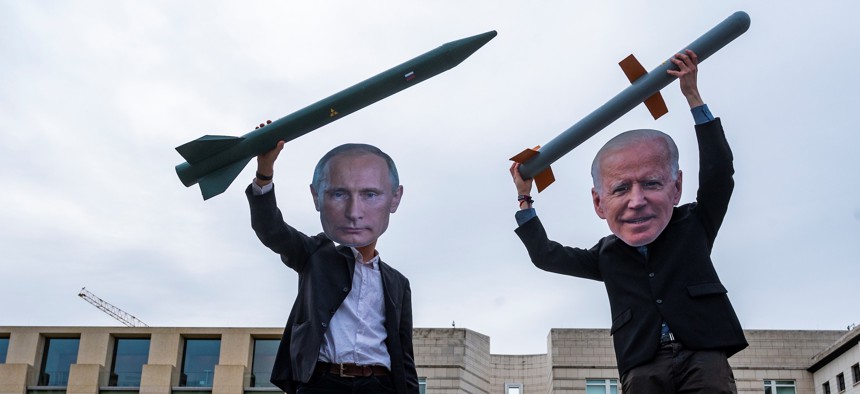
Peace activists wearing masks of Russian President Vladimir Putin (L) and newly elected US President Joe Biden in Berlin on January 29, 2021. John MACDOUGALL / AFP
The Biden-Putin Summit Could Produce Both a Little And a Lot
Moscow’s hybrid-war efforts limit what Wednesday’s meeting can accomplish, but even small agreements would make a big difference.
The world will be watching on Wednesday when Joe Biden meets for the first time as president with his Russian counterpart Vladimir Putin in Geneva. In an effort to manage expectations for what promises to be a tense exchange of grievances, the Biden administration insists its goal for the summit is simply a more “stable and predictable” relationship between the two nuclear-weapons superpowers. To grasp the difficulty for both sides to clear even that low bar, it’s important to understand just how unstable and dangerously unpredictable U.S.-Russia relations have become.
For instance, one of the administration’s first major foreign policy moves was the April expulsion of Russian diplomats and the imposition of new sanctions on several Russians and their companies. This was retaliation for Moscow’s repeat interference in U.S.presidential elections and its SolarWinds cyberattack, perhaps the largest-ever infiltration of U.S. government computer networks.
During the recent NATO summit, Biden likely heard from NATO ally the Czech Republic, which also recently expelled Russian “diplomats” in retaliation for an earlier Russian sabotage operation that included bombing a Czech arms depot and poisoning a Czech arms dealer with the Russian nerve agent Novichok. That operation was reportedly carried out by the same secret Russian military intelligence unit behind the similar attempted assassinations of former Russian military officer and double agent Sergei Skripal in Britain in 2018 and Russian opposition figure Alexei Navalny last year. The same unit was also allegedly behind an earlier plot to launch a military coup in Montenegro to keep it from joining the NATO alliance.
Just in recent weeks, evidence has mounted of Russia’s malign activities. Russian cyber-criminal groups that enjoy sanctuary courtesy of the Kremlin were behind the ransomware attacks on critical U.S. infrastructure: a major fuel pipeline and a meat processor. The U.S. intelligence community also believes Russia is the primary suspect in an escalating series of debilitating directed-energy attacks on more than 130 U.S. diplomats, intelligence agents and government officials. The attacks began in Havana, Cuba, in 2016, and have since spread and escalated, targeting U.S. officials in Beijing, Moscow and recently even in Washington, D.C. If Moscow is behind those attacks, it could be considered an act of war. Meanwhile, Russia is also reportedly preparing to sell Iran an advanced surveillance satellite that will allow its violent proxies in the Middle East to more accurately target U.S. troops and allies in the region.
Putin sees all of these destabilizing activities as part of a successful “hybrid war” that has undermined Western interests while staying just below the threshold of outright conflict. The constant cycle of provocation and escalation is both reckless and extremely dangerous, however, and harkens back to the earliest of the Cold War when miscalculations between the former Soviet Union and the United States led to existential crises like the Berlin Blockade and Cuban Missile Crisis.
To avoid a repeat of those dark days, Biden and Putin will need to articulate narrow areas of potential cooperation, and reach at least a tacit understanding of where each country sees a “red line” that, if crossed, is likely to lead to escalation and greater instability, particularly in the cyber arena. As during the Cold War, nuclear arms control is a good place to start trying to defuse this volatile relationship.
Biden and Putin actually got off on a rare positive track in January by agreeing to extend for the maximum five years the New Strategic Arms Reduction Treaty, which limits both sides to 1,500 deployed nuclear weapons and was set to expire imminently. After the parties left the Intermediate-Range Nuclear Forces Treaty in 2019, New START was the last remaining arms control treaty limiting the nuclear arsenals of the former Cold War rivals. The extension was a tacit admission that neither Washington nor Moscow has an interest in a runaway nuclear arms race.
With the United States and Russia possessing roughly 90 percent of nuclear warheads worldwide, Biden and Putin could build on that promising start by discussing further top-line reductions in their respective nuclear arsenals. They should agree on confidence-building measures such as a return of both countries to the Open Skies Treaty that allows overflight of military facilities, and a tacit understanding that despite the lapsing of the INF Treaty, the United States will not base any intermediate-range nuclear missiles on the European continent. The implications of new technologies such as hypersonic missiles should also be discussed. At the very least, the two leaders could agree on a mutual “red line” barring potentially catastrophic cyberattacks on nuclear command-and-control and early warning systems.
A true warming of U.S-Russian relations is beyond the reach of diplomacy, given today’s levels of tension and distrust and continued “hybrid war” provocations. The most that can be hoped for is modest progress in areas of mutual interest, and none is more strategically imperative than keeping the genie of nuclear weapons tightly bottled up during the current storm of geopolitical instability. That was the path once chosen by former President Ronald Reagan and Soviet leader Mikhail Gorbachev, and it eventually led to the end of the Cold War. When they face off in Geneva with the fate of humanity potentially in the balance, Presidents Joseph Biden and Vladimir Putin would do well to remember that history and the wisdom of their predecessors.
Glenn Nye III is President and CEO of the Center for the Study of the Presidency & Congress (CSPC). James Kitfield is a CSPC Senior Fellow.
NEXT STORY: NATO’s Nuclear Two-Step



